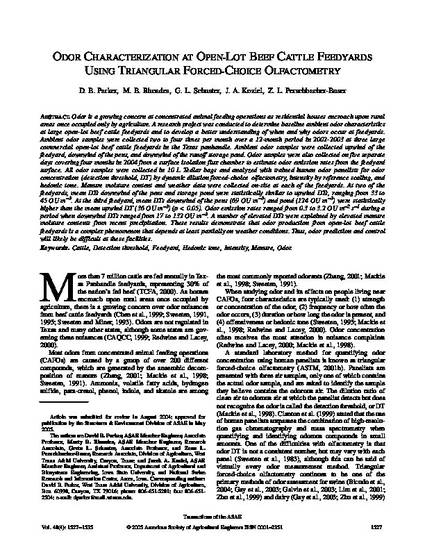
Odor is a growing concern at concentrated animal feeding operations as residential houses encroach upon rural areas once occupied only by agriculture. A research project was conducted to determine baseline ambient odor characteristics at large open-lot beef cattle feedyards and to develop a better understanding of when and why odors occur at feedyards. Ambient odor samples were collected two to four times per month over a 12-month period in 2002-2003 at three large commercial open-lot beef cattle feedyards in the Texas panhandle. Ambient odor samples were collected upwind of the feedyard, downwind of the pens, and downwind of the runoff storage pond. Odor samples were also collected on five separate days covering four months in 2004 from a surface isolation flux chamber to estimate odor emission rates from the feedyard surface. All odor samples were collected in 10 L Tedlar bags and analyzed with trained human odor panelists for odor concentration (detection threshold, DT) by dynamic dilution forced-choice olfactometry, intensity by reference scaling, and hedonic tone. Manure moisture content and weather data were collected on-site at each of the feedyards. At two of the feedyards, mean DTs downwind of the pens and storage pond were statistically similar to upwind DTs, ranging from 33 to 45 OU m-3. At the third feedyard, mean DTs downwind of the pens (69 OU m-3) and pond (124 OU m-3) were statistically higher than the mean upwind DT (36 OU m-3) (p < 0.05). Odor emission rates ranged from 0.3 to 3.2 OU m-2 s-1 during a period when downwind DTs ranged from 17 to 132 OU m-3. A number of elevated DTs were explained by elevated manure moisture contents from recent precipitation. These results demonstrate that odor production from open-lot beef cattle feedyards is a complex phenomenon that depends at least partially on weather conditions. Thus, odor prediction and control will likely be difficult at these facilities.
Available at: http://works.bepress.com/jacek_koziel/67/

This article is from Transaction of the ASAE 48, no. 4 (2005): 1527–1535.